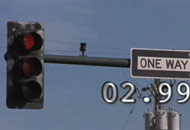1/11/2009
Colorado: Benefit of Yellow Timing Increase Documented in DenverLonger duration for yellow signals in Denver, Colorado brings 90 percent reduction in violations.

Increasing the duration of the yellow signals has had a greater safety impact than the use of red light cameras in Denver, Colorado. These facts emerged from a Rocky Mountain News investigation that also discovered that city officials and police made no effort whatsoever to track the performance of their public safety program beyond counting the 11,200 tickets worth $840,000 that had been issued between June and November.
Redflex Traffic Systems, the Australian company that operates the automated ticketing machines at four intersections in return for a cut of the profits, did not submit a single report to the city regarding maintenance or calibration of the cameras, despite being required to do so by contract. The city only requested these documents after the Rocky Mountain News made an inquiry to follow up on the program's performance.
In May, the same newspaper had forced Denver to increase the duration of yellow at the camera-monitored intersections by documenting how the city used yellow times of 3.0 seconds and under -- violating federal law in one case. At the posted 45 MPH intersection of northbound Quebec Street and 36th Avenue, the yellow increased from 3.0 to 5.0 seconds. Yellow rose from 3.0 to 4.0 seconds at both eastbound Sixth Avenue at Kalamath and westbound Eighth Avenue at Speer Boulevard. Yellow increased just half a second at eastbound Sixth at Lincoln Street to 3.5 seconds.
At the first three locations, Redflex had tested the number of "violations" that happened at each intersection when the yellow light was set to last 3.0 seconds, counting 125 in a 12-hour period. With the longer yellow, the new police data show a daily average of between nine and sixteen violations in a 24-hour period -- a drop of approximately 90 percent. This matches the long-term benefit of longer yellow documented after a similar lengthening took place at a Fairfax County, Virginia intersection. The camera at Sixth and Lincoln experienced less of a benefit -- an average of 53 daily violations -- after receiving the smallest increase of 0.5 seconds of extra yellow.


